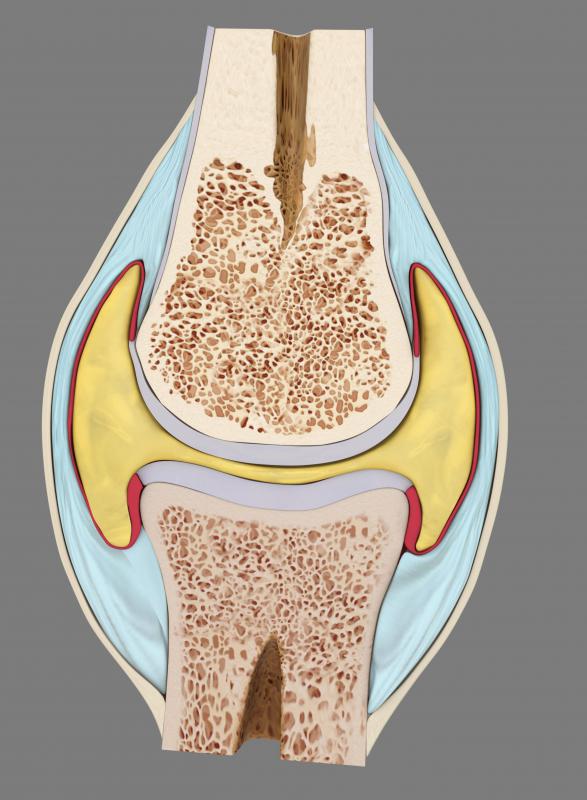At TheHealthBoard, we're committed to delivering accurate, trustworthy information. Our expert-authored content is rigorously fact-checked and sourced from credible authorities. Discover how we uphold the highest standards in providing you with reliable knowledge.
What is a Synchondrosis?
A synchondrosis is a joint that is connected with cartilage. Such joints are stiff and very strong and they can be found in several areas of the body. Many appear in childhood only, disappearing as people mature into adulthood. Such joints provide limited flexibility where it is needed, without the range of motion found in other types of joints. This makes a synchondrosis more stable and supportive.
A famous example of a synchondrosis is the sternocostal joint where the ribs meet the sternum. The rib cage is designed to protect the sensitive organs inside the chest while allowing some room for expansion. The synchondrosis allows the rib cage to absorb and distribute energy from impacts, while also permitting the chest to open up when people take a breath. The stiff nature of this joint explains why people sometimes develop fractures from cardiopulmonary resuscitation, especially if they are older adults, as the joint is not always flexible enough to withstand the repeated pressure of vigorous chest compressions.

Other examples can be found at sites on the long bones, known as epiphyseal growth plates. The growth plates allow bones to grow as people get older, while still providing support to the body. Over time, the hyaline cartilage in these synchondroses ossifies, turning into bone. Growth plates can provide information about how old someone is, depending on the degree of ossification. These joints harden entirely into bone by the time people reach their 20s.

The skull also has a number of synchondroses. When people are born, the skull is made up of a series of plates that are connected with cartilage. This allows the skull some room to grow, so that babies do not need to be born with full-sized heads to protect the brain. As people grow up, the seams between the skull plates gradually harden and smooth out. Specimens of skulls from people of various ages can be seen on display in some museums, illustrating how the stark lines found on younger skulls gradually fade with age.

People with connective tissue disorders can sometimes develop problems at a synchondrosis. This may be a result of overproduction of cartilage or excessive breakdown of cartilage. Because these joints are often sites of rapid growth in childhood and adolescence, they can also become cancerous. Cancers that develop in the bone can lead to bone pain and weakness and can be identified with medical imaging studies that will reveal growths in or on the bone. Treatment options are available to address overgrowths of cartilage and other problems that can develop with the bones.
AS FEATURED ON:
AS FEATURED ON:

















Discussion Comments
@cloudel – Yes, those synchondroses on babies' skulls do make us parents use extra caution. There is one on the back and the front of a baby's head, so you have to be careful in both directions.
The synchondrosis on the back of the head usually closes up after a couple of months, but the one on the front can take over a year. My pediatrician said that this is because about half of your brain's growth happens during your first year of life, and the skull has to accommodate it.
It's pretty cool how our bodies are designed with synchondroses that allow for flexibility like this. It's also a little scary because of the potential for damaging the area.
I was unaware of the fact that CPR can cause damage to the synchondrosis of the sternum. It's sad that something that could save your life could also make you suffer.
My sister damaged her sternum in a car accident. Her chest rammed into the steering wheel, and she fractured it.
You don't really appreciate the flexibility of your synchondrosis until it is negatively affected. She could not take deep breaths, and even regular breathing caused her pain during the three months following the accident.
Her doctor told her that a brace would not be good for her, because it would further inhibit her breathing. She just had to take pain meds and anti-inflammatory pills to help her deal with the pain.
I suppose that synchondroses in the skull are responsible for those soft spots on babies' heads. I have always heard that they exist mainly so the head can be squeezed more easily out of the birthing canal.
That is probably why so many newborns appear to have long, alien-like heads. They become more normal over time, but at first, many newborns are scary looking!
I've always been told to be careful with infants, because you can cause irreparable damage if you injure one on its soft spot. I try to avoid handling newborn babies, because I am too scared I will drop them and damage them for life.
Post your comments